Page 173 of 706
3-80 Features and controls
3
NOTE�When the gearshift lever or the selector lever is in the “R”
(REVERSE) position with the ignition switch in the “ON”
position, the rear-view camera image will be displayed on
the left portion of a type 3 mirror.
For details, refer to “Rear-view camera” on page 3-169.Adjust the inside mirror to maximize the view through the rear
window.
To adjust the vertical mirror positionIt is possible to move the mirror up and down to adjust its posi-
tion.
Ty p e 1
Ty p e 2
Ty p e 3BK0151000US.book 80 ページ 2012年3月29日 木曜日 午後6時8分
Page 182 of 706
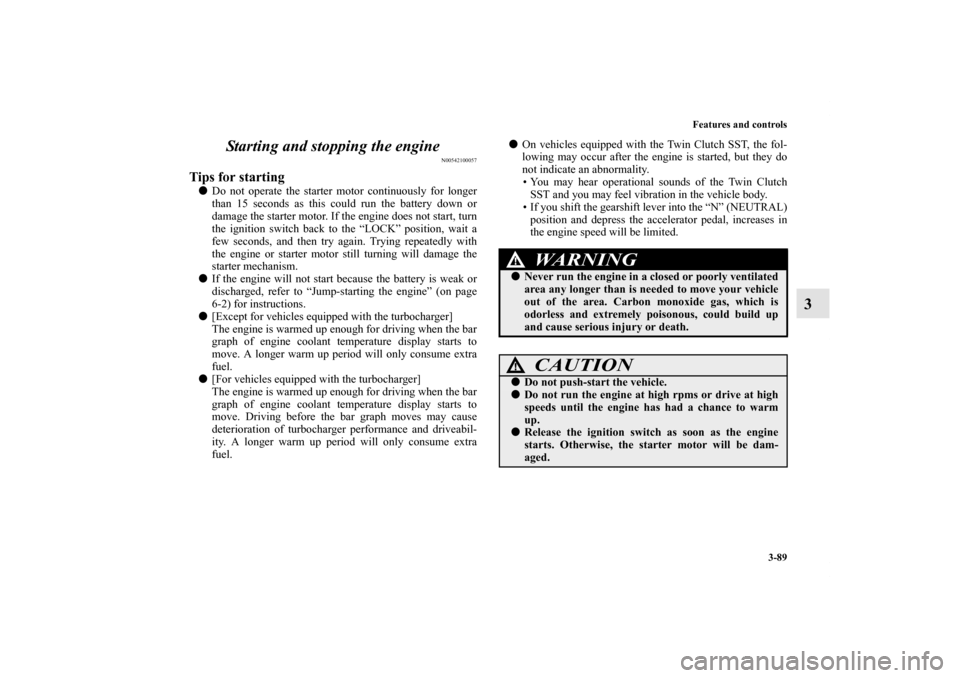
Features and controls
3-89
3 Starting and stopping the engine
N00542100057
Tips for starting �Do not operate the starter motor continuously for longer
than 15 seconds as this could run the battery down or
damage the starter motor. If the engine does not start, turn
the ignition switch back to the “LOCK” position, wait a
few seconds, and then try again. Trying repeatedly with
the engine or starter motor still turning will damage the
starter mechanism.
�If the engine will not start because the battery is weak or
discharged, refer to “Jump-starting the engine” (on page
6-2) for instructions.
�[Except for vehicles equipped with the turbocharger]
The engine is warmed up enough for driving when the bar
graph of engine coolant temperature display starts to
move. A longer warm up period will only consume extra
fuel.
�[For vehicles equipped with the turbocharger]
The engine is warmed up enough for driving when the bar
graph of engine coolant temperature display starts to
move. Driving before the bar graph moves may cause
deterioration of turbocharger performance and driveabil-
ity. A longer warm up period will only consume extra
fuel.�On vehicles equipped with the Twin Clutch SST, the fol-
lowing may occur after the engine is started, but they do
not indicate an abnormality.
• You may hear operational sounds of the Twin Clutch
SST and you may feel vibration in the vehicle body.
• If you shift the gearshift lever into the “N” (NEUTRAL)
position and depress the accelerator pedal, increases in
the engine speed will be limited.
WA R N I N G
!�Never run the engine in a closed or poorly ventilated
area any longer than is needed to move your vehicle
out of the area. Carbon monoxide gas, which is
odorless and extremely poisonous, could build up
and cause serious injury or death.
CAUTION
!�Do not push-start the vehicle.�Do not run the engine at high rpms or drive at high
speeds until the engine has had a chance to warm
up.�Release the ignition switch as soon as the engine
starts. Otherwise, the starter motor will be dam-
aged.
BK0151000US.book 89 ページ 2012年3月29日 木曜日 午後6時8分
Page 193 of 706
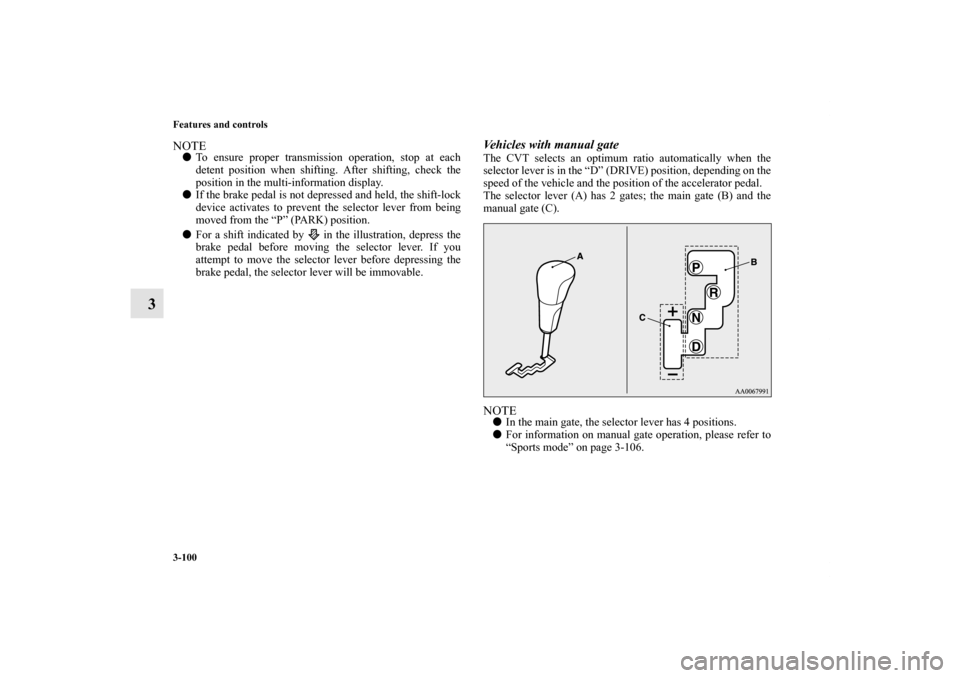
3-100 Features and controls
3
NOTE�To ensure proper transmission operation, stop at each
detent position when shifting. After shifting, check the
position in the multi-information display.
�If the brake pedal is not depressed and held, the shift-lock
device activates to prevent the selector lever from being
moved from the “P” (PARK) position.
�For a shift indicated by in the illustration, depress the
brake pedal before moving the selector lever. If you
attempt to move the selector lever before depressing the
brake pedal, the selector lever will be immovable.
Vehicles with manual gateThe CVT selects an optimum ratio automatically when the
selector lever is in the “D” (DRIVE) position, depending on the
speed of the vehicle and the position of the accelerator pedal.
The selector lever (A) has 2 gates; the main gate (B) and the
manual gate (C).NOTE�In the main gate, the selector lever has 4 positions.
�For information on manual gate operation, please refer to
“Sports mode” on page 3-106.
BK0151000US.book 100 ページ 2012年3月29日 木曜日 午後6時8分
Page 194 of 706
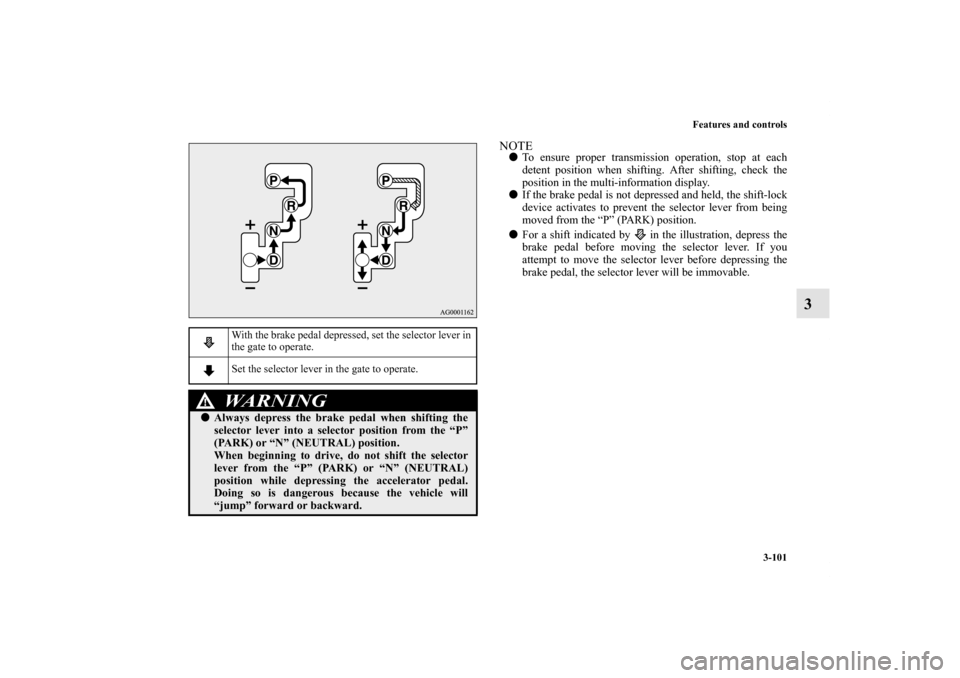
Features and controls
3-101
3
NOTE�To ensure proper transmission operation, stop at each
detent position when shifting. After shifting, check the
position in the multi-information display.
�If the brake pedal is not depressed and held, the shift-lock
device activates to prevent the selector lever from being
moved from the “P” (PARK) position.
�For a shift indicated by in the illustration, depress the
brake pedal before moving the selector lever. If you
attempt to move the selector lever before depressing the
brake pedal, the selector lever will be immovable.
With the brake pedal depressed, set the selector lever in
the gate to operate.
Set the selector lever in the gate to operate.WA R N I N G
!�Always depress the brake pedal when shifting the
selector lever into a selector position from the “P”
(PARK) or “N” (NEUTRAL) position.
When beginning to drive, do not shift the selector
lever from the “P” (PARK) or “N” (NEUTRAL)
position while depressing the accelerator pedal.
Doing so is dangerous because the vehicle will
“jump” forward or backward.
BK0151000US.book 101 ページ 2012年3月29日 木曜日 午後6時8分
Page 196 of 706
Features and controls
3-103
3
Selector lever position display
N00513900428
When the ignition switch is turned to the “ON” position, the
selector lever position is shown on the multi-information dis-
play.
Warning display
N00514000240
Ty p e 1
or
Ty p e 2
or
When the warning display or the warning display
appears on the information screen in the multi-information dis-
play while you are driving, there could be a malfunction in the
CVT.
BK0151000US.book 103 ページ 2012年3月29日 木曜日 午後6時8分
Page 197 of 706
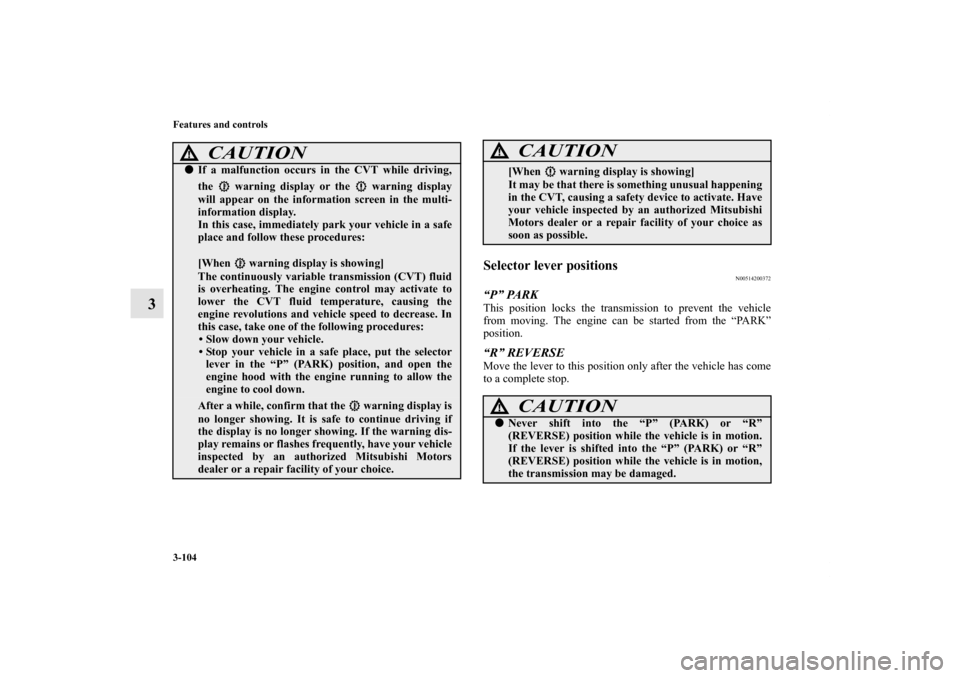
3-104 Features and controls
3
Selector lever positions
N00514200372
“P” PARKThis position locks the transmission to prevent the vehicle
from moving. The engine can be started from the “PARK”
position.“R” REVERSEMove the lever to this position only after the vehicle has come
to a complete stop.
CAUTION
!�If a malfunction occurs in the CVT while driving,
the warning display or the warning display
will appear on the information screen in the multi-
information display.
In this case, immediately park your vehicle in a safe
place and follow these procedures:
[When warning display is showing]
The continuously variable transmission (CVT) fluid
is overheating. The engine control may activate to
lower the CVT fluid temperature, causing the
engine revolutions and vehicle speed to decrease. In
this case, take one of the following procedures:
• Slow down your vehicle.
• Stop your vehicle in a safe place, put the selector
lever in the “P” (PARK) position, and open the
engine hood with the engine running to allow the
engine to cool down.After a while, confirm that the warning display is
no longer showing. It is safe to continue driving if
the display is no longer showing. If the warning dis-
play remains or flashes frequently, have your vehicle
inspected by an authorized Mitsubishi Motors
dealer or a repair facility of your choice.
[When warning display is showing]
It may be that there is something unusual happening
in the CVT, causing a safety device to activate. Have
your vehicle inspected by an authorized Mitsubishi
Motors dealer or a repair facility of your choice as
soon as possible. CAUTION
!�Never shift into the “P” (PARK) or “R”
(REVERSE) position while the vehicle is in motion.
If the lever is shifted into the “P” (PARK) or “R”
(REVERSE) position while the vehicle is in motion,
the transmission may be damaged.
CAUTION
!
BK0151000US.book 104 ページ 2012年3月29日 木曜日 午後6時8分
Page 202 of 706
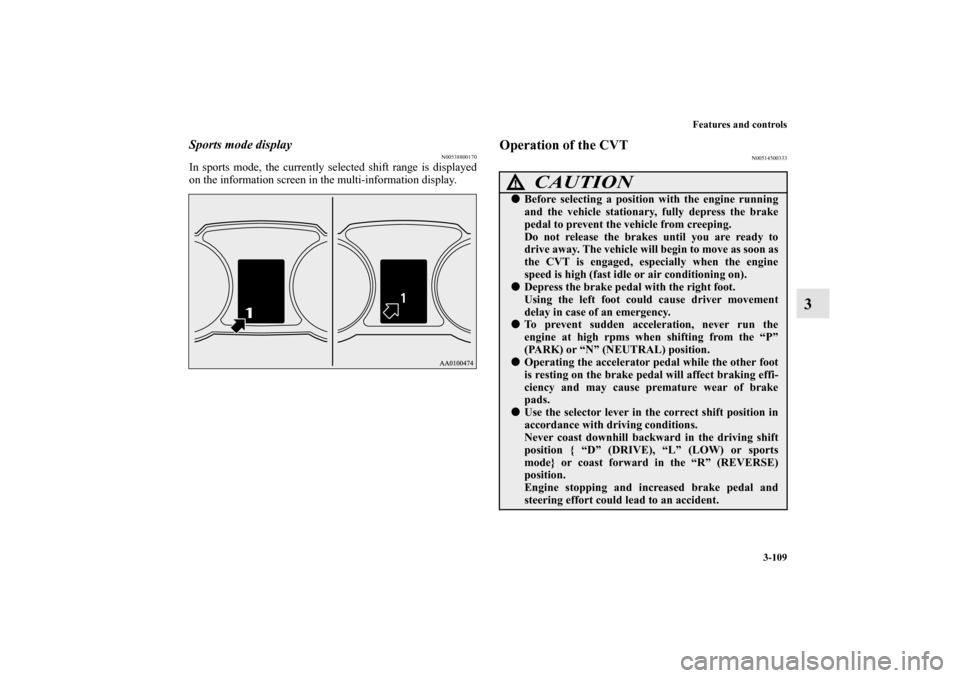
Features and controls
3-109
3
Sports mode display
N00538800170
In sports mode, the currently selected shift range is displayed
on the information screen in the multi-information display.
Operation of the CVT
N00514500333
CAUTION
!�Before selecting a position with the engine running
and the vehicle stationary, fully depress the brake
pedal to prevent the vehicle from creeping.
Do not release the brakes until you are ready to
drive away. The vehicle will begin to move as soon as
the CVT is engaged, especially when the engine
speed is high (fast idle or air conditioning on).�Depress the brake pedal with the right foot.
Using the left foot could cause driver movement
delay in case of an emergency.�To prevent sudden acceleration, never run the
engine at high rpms when shifting from the “P”
(PARK) or “N” (NEUTRAL) position.�Operating the accelerator pedal while the other foot
is resting on the brake pedal will affect braking effi-
ciency and may cause premature wear of brake
pads.�Use the selector lever in the correct shift position in
accordance with driving conditions.
Never coast downhill backward in the driving shift
position { “D” (DRIVE), “L” (LOW) or sports
mode} or coast forward in the “R” (REVERSE)
position.
Engine stopping and increased brake pedal and
steering effort could lead to an accident.
BK0151000US.book 109 ページ 2012年3月29日 木曜日 午後6時8分
Page 204 of 706
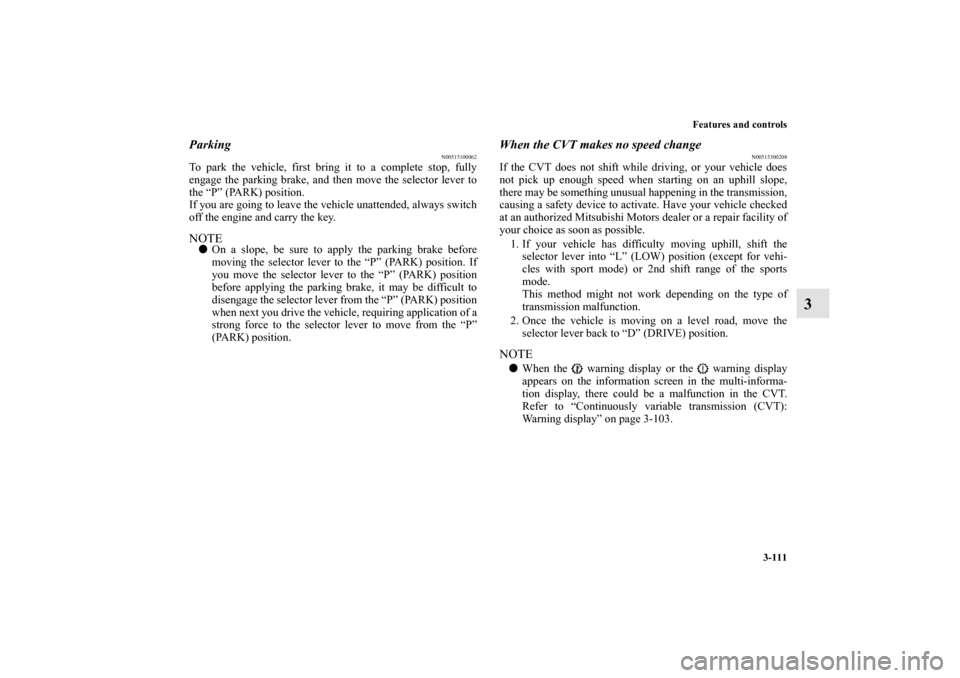
Features and controls
3-111
3
Parking
N00515100062
To park the vehicle, first bring it to a complete stop, fully
engage the parking brake, and then move the selector lever to
the “P” (PARK) position.
If you are going to leave the vehicle unattended, always switch
off the engine and carry the key.NOTE�On a slope, be sure to apply the parking brake before
moving the selector lever to the “P” (PARK) position. If
you move the selector lever to the “P” (PARK) position
before applying the parking brake, it may be difficult to
disengage the selector lever from the “P” (PARK) position
when next you drive the vehicle, requiring application of a
strong force to the selector lever to move from the “P”
(PARK) position.
When the CVT makes no speed change
N00515300208
If the CVT does not shift while driving, or your vehicle does
not pick up enough speed when starting on an uphill slope,
there may be something unusual happening in the transmission,
causing a safety device to activate. Have your vehicle checked
at an authorized Mitsubishi Motors dealer or a repair facility of
your choice as soon as possible.
1. If your vehicle has difficulty moving uphill, shift the
selector lever into “L” (LOW) position (except for vehi-
cles with sport mode) or 2nd shift range of the sports
mode.
This method might not work depending on the type of
transmission malfunction.
2. Once the vehicle is moving on a level road, move the
selector lever back to “D” (DRIVE) position.NOTE�When the warning display or the warning display
appears on the information screen in the multi-informa-
tion display, there could be a malfunction in the CVT.
Refer to “Continuously variable transmission (CVT):
Warning display” on page 3-103.
BK0151000US.book 111 ページ 2012年3月29日 木曜日 午後6時8分